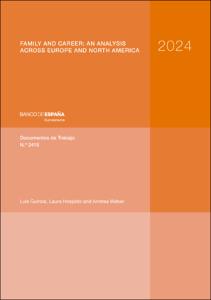Family and career: an analysis across Europe and North America
Authors
Issue Date
20-May-2024
Physical description
31 p.
Abstract
Utilizando datos de 17 países de Europa y Norteamérica, comparamos las trayectorias profesionales de hombres y mujeres con y sin hijos, de diferentes cohortes y en distintos puntos de su ciclo vital. Existe una amplia variación entre países en lo referente a las brechas de empleo y salariales a la edad de 30 años. Sin embargo, a los 50 años, la brecha de empleo entre madres y no madres se cierra en la mayoría de países. También observamos una convergencia en las brechas de empleo entre madres y padres a los 50 años, aunque estas brechas no se cierran completamente. Las brechas salariales también se cierran a la edad de 50 años entre madres y no madres, particularmente entre aquellas con estudios superiores, pero hay una fuerte persistencia de las brechas salariales entre madres y padres incluso entre aquellos con estudios superiores. Las principales razones de las restantes brechas en etapas posteriores del ciclo vital son el trabajo a tiempo parcial entre mujeres y la prima por paternidad, ya que los ingresos salariales de los padres superan a los de los no padres a lo largo de su ciclo vital.
Using data for 17 countries in Europe and North America, we compare the career trajectories of mothers and fathers and of women and men without children across cohorts and at different points in their life cycle. There is wide cross-country variation in employment and earnings gaps at age 30. At age 50, however, employment gaps between mothers and non-mothers have closed in most countries. We also observe convergence in employment gaps between mothers and fathers by age 50, but these gaps do not close altogether. Motherhood gaps in earnings also close by age 50 between mothers and non-mothers, particularly among the highly educated. But there is strong persistence in earnings gaps between mothers and fathers even among highly educated parents. The main reasons for the remaining gaps at later stages in the life-cycle are part-time work among women and fatherhood premia as fathers’ earnings outperform non-fathers’ over their life-cycle.
Using data for 17 countries in Europe and North America, we compare the career trajectories of mothers and fathers and of women and men without children across cohorts and at different points in their life cycle. There is wide cross-country variation in employment and earnings gaps at age 30. At age 50, however, employment gaps between mothers and non-mothers have closed in most countries. We also observe convergence in employment gaps between mothers and fathers by age 50, but these gaps do not close altogether. Motherhood gaps in earnings also close by age 50 between mothers and non-mothers, particularly among the highly educated. But there is strong persistence in earnings gaps between mothers and fathers even among highly educated parents. The main reasons for the remaining gaps at later stages in the life-cycle are part-time work among women and fatherhood premia as fathers’ earnings outperform non-fathers’ over their life-cycle.
Publish on
Documentos de Trabajo / Banco de España, 2415
Subjects
Brechas de género; Empleo; Ingresos salariales; Hijos; Gender gaps; Employment; Earnings; Children; Renta; Economía del trabajo; Europa; América del Norte
Appears in Collections:












